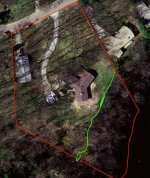Looks like we've got a couple of experienced folks (perhaps surveyors) speaking up here...
I have a question -- growing up in the hills of East Tennessee, in the foothills of the Smoky Mountains, the land is often quite steep and full of variations in terrain of all types -- hills, valleys, rock bluffs, gulleys/ravines, etc. The "more-or-less" acreage statement on older deeds can vary by huge amounts from the acreage computed by modern surveyors and modern equipment. Another example, our family farm lay almost entirely on a side of a 2800' mountain, from its base to slightly across the crest. Its acreage was recorded in three different official places (Register of Deeds, Tax Assessor and ASCS office) as 136 acres, 165 acres and 196 acres -- though I can't remember which was which...
I've been told that old surveys tried to take into account the "3-D topology" of the terrain in their acreage computations, consequently the "more or less" was just an estimate that considered the topography, while modern surveys treat the boundaries as if the land were totally flat. Is that truly the case?
For example, in a 3-D model of a large piece of property that is full of hills and valleys, if you consider the area (i.e. acreage) on the face of all those hillsides, it could easily increase the acreage by 1/4, 1/3 or more....
...


